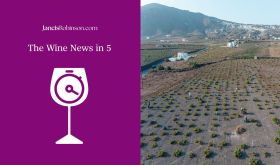In case you weren’t with us last week and you are a podcast listener – we have a new podcast channel called ‘The Wine News in 5’ and it’s where the audio version of this podcast will live from now on.
Extreme weather in Europe
On Sunday 12 May the Marne Valley in Champagne was hit by a massive hailstorm affecting between 450 and 500 hectares (1,110–1,240 acres). French publication Vitisphere reported that the most heavily impacted communes include Trélou-sur-Marne, Courcelles, Passy-sur-Marne and Barzy-sur-Marne, with 50–100% damage in affected areas. This level of impact is exceptional, as hail is generally far more localised. In addition to physical damage, remaining green tissue is now especially vulnerable to downy mildew – and this year mildew pressure is especially high in Champagne due to frequent rain.
Speaking of rain, rain has been incessant in south-west Germany, eastern France and northern Italy and on Friday 17 May flood warnings were issued throughout much of south-west Germany. In the Bas-Rhin and Moselle regions of Alsace rivers began to swell and burst their banks. In Germany flash floods and landslides in the Mosel began on Friday afternoon affecting the Trier-Saarburg district of western Germany. Our Germany specialist Paula Sidore reported for her publication Trink that many Mosel tributaries reached 10-, 20- or even 50-year highs for water levels. The town of Zell, a large winegrowing community, has been flooded since last Saturday. While cellars have doubtless flooded, Paula points out that along the Mosel and its tributaries flooding is common and growers have contingency plans (she recommended watching a video from the Instagram profile of producer Selbach Oster, who posted about securing their barrels for flooding). We haven’t heard from any producers in Alsace or northern Italy on the flooding there – so if you know more, please drop info in the comments, in our forum, or email me at news@jancisrobinson.com.
The US government’s impending update to dietary guidelines
The US government is due to update dietary guidelines in 2025. Last Monday, Tom Wark, who is the executive director of the National Association of Wine Retailers, wrote on his blog that an undisclosed source had told him that the proposed wording of the update means that the US will soon be joining the WHO in declaring that there is ‘no safe level’ of alcohol consumption. On Tuesday, Blake Gray of Wine-Searcher pointed out that on 4 April the US House of Representatives House Committee on Oversight and Accountability sent a letter to the National Academies of Science, Engineering and Medicine (NASEM) – to whom they had allocated $1.3 million in order to study the relationship between alcohol consumption and cancer, obesity and heart disease. This letter requested documents be provided proving NASEM was using sound and objective scientific evidence because, and I quote from the letter, ‘Despite a statutory mandate to NASEM to complete this review, the Department of Health and Human Services (HHS) has apparently taken control of this process by “delegating” the Dietary Guidelines alcohol review to the Interagency Coordinating Committee on the Prevention of Underage Drinking (ICCPUD), led by the Substance Abuse and Mental Health Services Administration (SAMHSA).’
It seems pretty safe to say that having the people who are responsible for substance abuse prevention directly involved with dietary guidelines regarding alcohol is a conflict of interest. But that’s what’s happened. So for those of you who will soon be listening to these recommendations and are concerned about your health in relation to alcohol – please know that as recently as June 2023 BMC Medicine, an open-access journal for medical education, published a paper titled ‘Alcohol consumption and all-cause and cause-specific mortality among US adults: prospective cohort study’, which confirmed the existence of the J-curve, which is the name given to the research that shows a protective health effect that occurs when you consume low to moderate levels of alcohol, above which you greatly increase your health risks. It’s so named because if you plot it, it looks like a J. The number that constitutes moderate drinking, depending on weight and gender, is around 1–2 drinks a day. So please, for the sake of the wine industry and your own mental health, don’t lose sleep over your daily glass of wine.
James Millton’s conviction for smuggling vine cuttings
James Millton is a well-known and well-respected proponent of organic and biodynamic farming who founded New Zealand’s first organic and biodynamic winery in 1984 – The Millton Vineyards & Winery. On 20 May, The New Zealand Herald published an article saying that he had been sentenced to five months of community detention and fined NZ$15,000 for bringing in illegal vine cuttings from his daughter’s property in Adelaide, Australia …
I know we all hear romantic stories about imports from famous estates in Burgundy or Bordeaux smuggled in a suitcase but honestly, there’s a very good reason for Millton’s conviction. This is how phylloxera and downy mildew spread from the US to most major winegrowing regions. It’s likely how esca and eutypa were transported, and if someone were to grab random cuttings from California or Oregon, they would have a decent chance of carrying red blotch to a whole new country … Australia has viral diseases that New Zealand does not have. So, while it may be nice to hear the old stories and laugh at the blissful naivety of the good old days, regulations around plant material are there for a reason. I will throw Millton a bit of a bone – plenty of people have smuggled plant material. The unusual thing about this is that he was caught and convicted.
The end, as we know it, of the International Pinot Noir Celebration
On Wednesday I opened my inbox to an email from IPNC saying that this July will mark the last IPNC in its current form. The celebration has happened at Linfield University nearly every year since 1987. But between the pressures of COVID – with no event being held in 2020 or 2021 – as well as flagging ticket sales, the event cannot afford to continue. Tickets for the event are $1,700 per person – and younger consumers are less willing, or perhaps less able, to splash out for a three-day wine-drinking event. I called the president of the board of directors, Thomas Savre, who said that if this year’s event sells 150 tickets in the next two months, then the event may be able to be pared down and restructured to offer more à la carte options in 2025 without the current grandeur. However, if ticket sales remain as they are, this year will truly be the last IPNC.
This is a transcript of our weekly five-minute news broadcast, which you can watch below. You can also listen to it on The JancisRobinson.com Podcast. If you have breaking news in your area, please email news@jancisrobinson.com. And if you enjoy this content and would like to see more like it, please subscribe to our site and our weekly newsletter.













